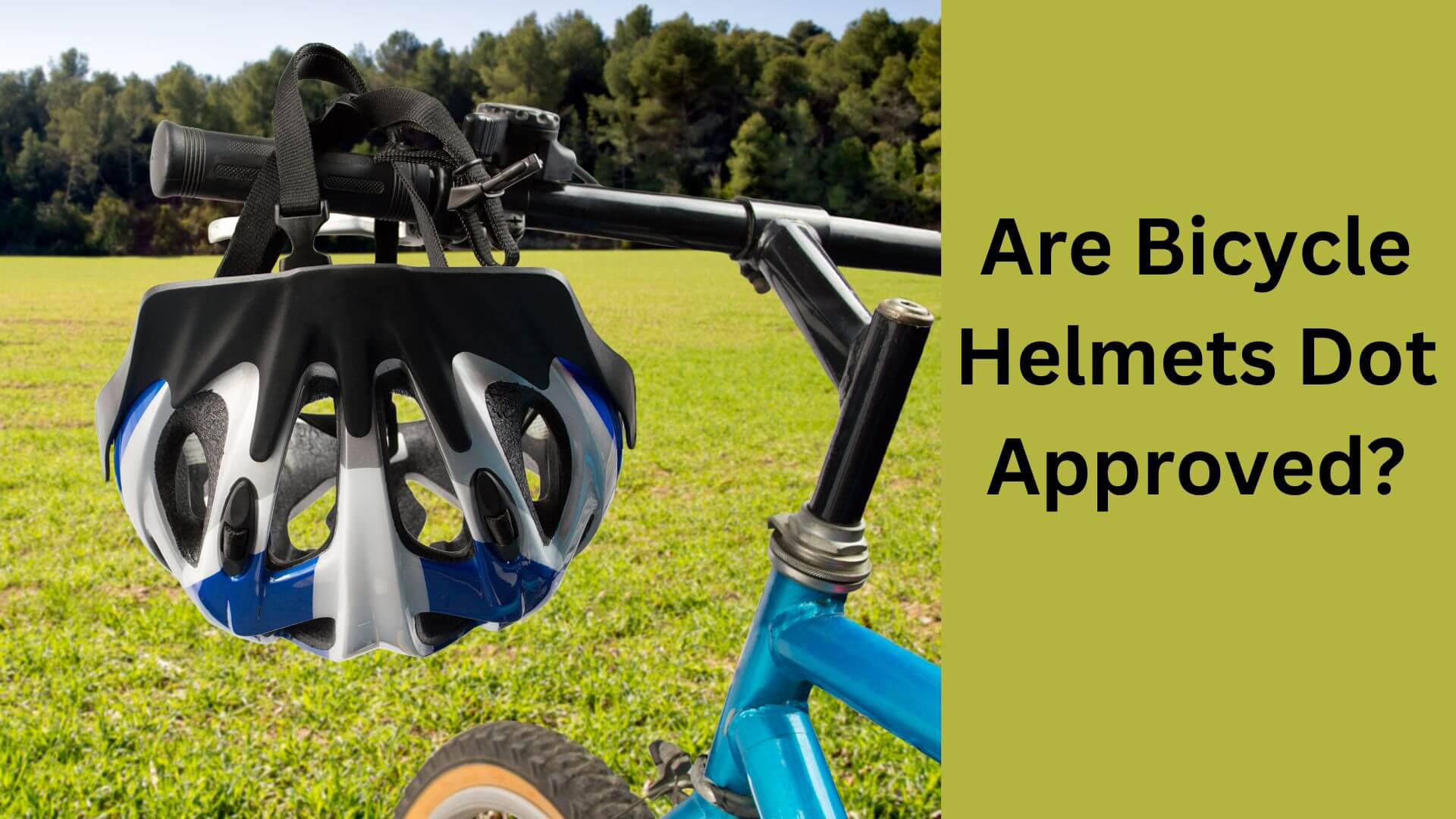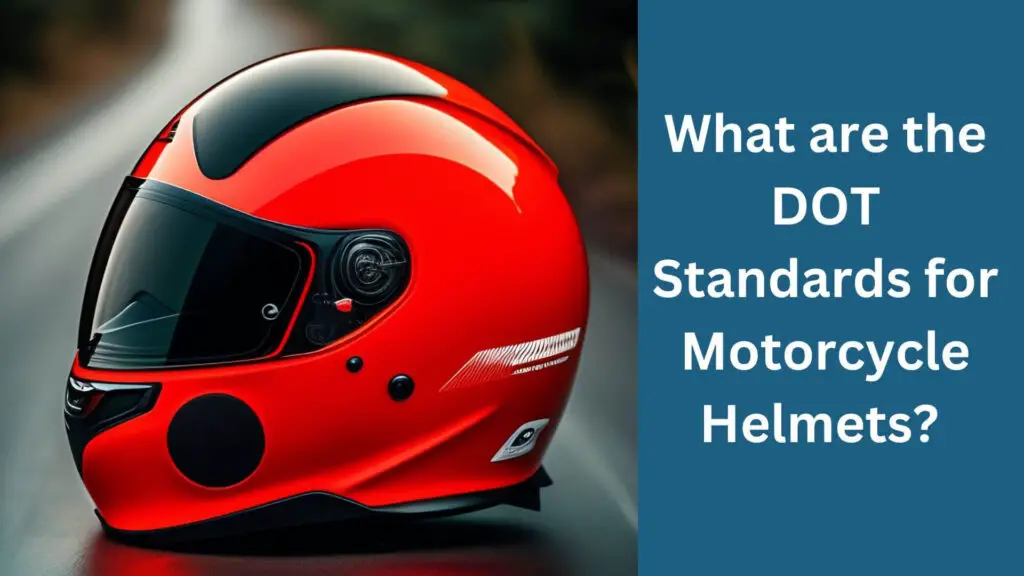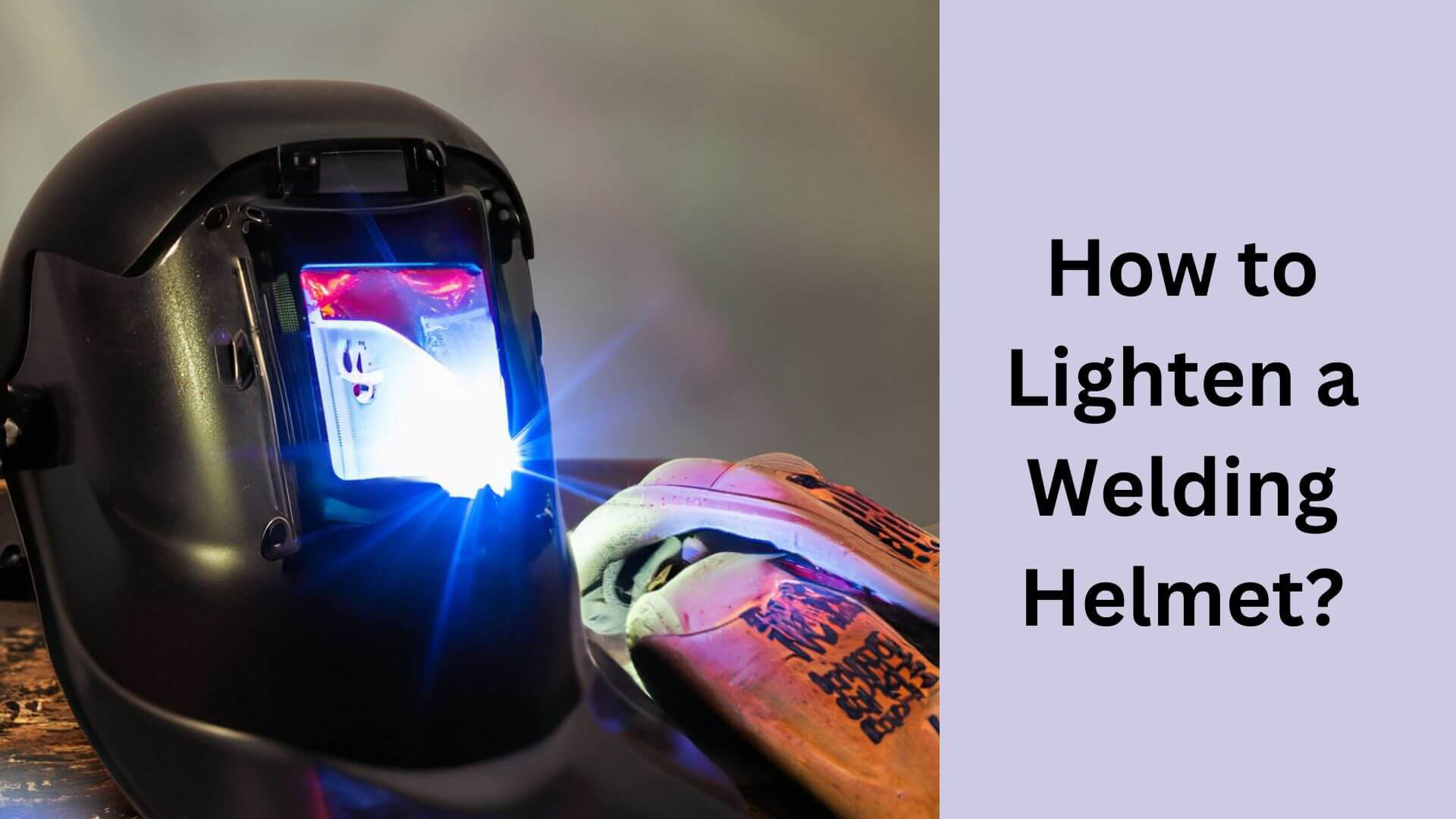Are Bicycle Helmets Dot Approved in Your State?

If you ride a motorcycle, wearing a helmet is an intelligent choice and a legal requirement in most states. But do you know what DOT approval means and why it is essential for motorcycle helmets?
DOT stands for Department of Transportation, the federal agency that sets the minimum safety standards for helmets on public roads and highways.
A DOT-approved helmet means that it has passed rigorous tests to ensure it can protect your head and brain in a crash.
However, if you ride a bicycle, you don’t need to look for a DOT sticker on your helmet. Bicycle helmets have different safety standards and certifications more suitable for their intended use.
In this article, I will explain the main differences between motorcycle and bicycle helmets,l safety standards for bicycle helmets such as CPSC (U.S) and EN1078 (EU), and whether any bicycle helmets are DOT approved.
What is DOT?

DOT stands for the Department of Transportation, a US government agency responsible for regulating transportation, including motor vehicles and highways. DOT has set safety standards for various transportation-related products, including helmets.
What are the DOT Standards for Motorcycle Helmets?

The DOT standards for motorcycle helmets are based on the Federal Motor Vehicle Safety Standard (FMVSS) 2181, which defines the minimum levels of performance that helmets must meet to protect the head and brain in the event of a crash.
The standard covers attenuation, penetration resistance, retention system effectiveness, and labeling.
The DOT tests helmets by dropping them onto a steel anvil at a speed of about 13.4 mph and measuring the force transmitted to a head from inside the helmet.
The helmet must not transmit more than 400 g of force to the head form. The DOT also tests helmets for penetration resistance by striking them with a pointed object at about 9.8 mph.
The object must not penetrate more than 0.08 inches into the helmet.
What are the CPSC and EN1078 Standards for Bicycle helmets?

The CPSC and EN1078 standards for bicycle helmets are two sets of regulations that apply to other regions.
The CPSC standard is mandatory for all bicycle helmets sold in the United States, while the EN1078 standard is mandatory for all bicycle helmets sold in the European Union.
- The CPSC standard requires that bicycle helmets meet specific criteria for impact attenuation, penetration resistance, retention system strength and stability, and labeling.
The CPSC tests helmets by dropping them onto flat and hemispherical anvils at different speeds and measuring the force transmitted to a head from inside the helmet.
The helmet must not transmit more than 300 g of force to the head form. The CPSC also tests helmets for penetration resistance by striking them with a sharp object at about 13 mph. The thing must not penetrate more than 0.25 inches into the helmet.
- The EN1078 standard also requires that bicycle helmets meet specific criteria for impact attenuation, retention system strength, stability, the field of vision, and marking and information.
The EN1078 tests helmets by dropping them onto flat and kerbstone anvils at different speeds and measuring the force transmitted to a head from inside the helmet. The helmet must not send more than 250 g of power to the head form.
Some examples of CPSC- and EN1078-certified bicycle helmets are:
- Giro Syntax MIPS Helmet: This helmet features a polycarbonate shell with EPS liner, an integrated MIPS system that reduces rotational forces on the brain in specific impacts, a Roc Loc 5 Air fit system allows easy adjustment and ventilation, and 25 wind tunnel vents that keep you cool.
- POC Omne Air Spin Helmet: This helmet features a high-density EPS core with optimized density zones, a SPIN technology that uses silicone pads to enhance impact absorption, an adjustable fit system with a 360-degree adjustment dial, and an optimized shape that provides good coverage without compromising visibility.
- Kask Rapido Helmet: This helmet features in-mold construction with an EPS liner, a retention system with up-and-down adjustment for comfort and stability, 24 large air vents for airflow and cooling, and reflective stickers on the back for visibility4.
Read More: What to Look for in a Bike Helmet?
How to Identify a DOT-Approved Bicycle Helmet?
Here are some steps to identify a DOT-approved bicycle helmet:
- Look for a “DOT” sticker on the back of the helmet. A “DOT” sticker is mandated on all helmets that meet the DOT’s safety requirements. This decal alone does not guarantee that the helmet is DOT-approved, as it is common for counterfeit DOT stickers to be affixed to non-compliant helmets.
- Feel the interior of the helmet for a thick inner liner. All DOT-approved helmets must have a one-inch-thick inner liner. The inner liner isn’t always visible, but you should be able to feel its thickness by moving your hand around the inside of the helmet.
- Ensure that the chinstrap is secure and does not feel loose or fragile by tugging on it. The chin strap should be securely attached to both sides of the helmet and be adjustable for a snug fit.
- Weigh the helmet. A DOT-certified helmet should weigh at least three pounds. Anything lighter than that may not provide adequate protection in a crash.
- Check for other labels or markings indicating compliance with others, such as CPSC (Consumer Product Safety Commission) or ANSI (American National Standards Institute). These labels may not be required for bicycle helmets, but they can provide additional quality assurance and safety.
I hope this helps you find a safe and comfortable bicycle helmet!
Are there Any Bicycle Helmets that are DOT Approved?
There are very few bicycle helmets that are DOT approved. DOT stands for Department of Transportation, a standard for motorcycle helmets in the United States.
DOT-approved helmets must meet specific criteria for impact absorption, penetration resistance, retention system strength and stability, and labeling.
Most bicycle helmets are not DOT-approved because they are designed for different purposes and conditions than motorcycle helmets.
Bicycle helmets are typically lighter, more ventilated, and less bulky than motorcycle helmets. They also have lower speed ratings and impact thresholds than motorcycle helmets.
Bicycle helmets are usually certified by CPSC (U.S) or EN1078 (EU) standards, which have different testing methods and requirements than DOT.
One exception of a bicycle helmet that was DOT approved was the Kali Protectives Shiva™, a full-face helmet that carried both CPSC and DOT certifications.
This helmet was designed for downhill mountain biking and BMX racing, where riders may encounter higher speeds and more severe impacts than typical cycling scenarios.
The helmet featured a composite fusion technology that used multiple foam densities to absorb impacts better than traditional EPS liners.
The helmet also had a breakaway visor system that reduced rotational forces on the head in case of a crash.
Read More: Can I use a Bike Helmet for Roller Skating?
Choosing the Right Bicycle Helmet for Your Needs?
Choosing the fitting bicycle helmet for your needs depends on four things:
- Your riding style: You should pick a helmet that matches your type of cycling, such as road, mountain, or recreational. Different types have different features, such as ventilation, aerodynamics, protection, and weight.
- Your head size: You should measure your head circumference with a flexible tape measure, string, or ruler. Then you should compare your measurement with the helmet sizing chart of the manufacturer. You should choose a helmet that fits snugly but comfortably on your head.
- Your helmet fit: You should adjust the tightness of the helmet with a dial or pads until it feels secure. You should also buckle and tighten the chin strap so that it forms a V under your ears. The helmet should sit level on your head and cover most of your forehead.
- Your helmet features: You should consider what special features you may want in a helmet, such as new protection technologies (MIPS, SPIN, WaveCel), built-in mounts for lights or cameras, visors, reflective stickers, etc. These features may affect the price and performance of the helmet.
What are the Benefits of Wearing a DOT-Approved Bicycle Helmet?
Some of the benefits of wearing a DOT-approved bicycle helmet are:
- It reduces serious head injuries by 60%.
- It reduces traumatic brain injury by 53%.
- 34% fewer cyclists are killed or severely injured.
- It protects against rotational forces if you fall (using MIPS technology).
- It meets established safety standards for impact protection.
Wearing a helmet is considered the most effective way to prevent head and brain injuries if you somehow tumble off your two-wheeler. This convinces you to wear a helmet whenever you ride a bike!
Read More: How Often Should You Replace Your Bike Helmet?
Frequently Asked Questions (FAQs) about Bicycle Helmets and DOT Approval
What is the Snell Memorial Foundation certification for helmets?
The Snell Memorial Foundation is a non-profit organization that sets safety standards for helmets. Snell certification is an indication that a helmet has passed rigorous safety tests.
Can I wear a motorcycle helmet for cycling?
You can wear a motorcycle helmet for cycling, but it may not be as comfortable or suitable as a bicycle helmet. Additionally, not all motorcycle helmets meet bicycle safety standards.
Are all bicycle helmets CPSC certified?
No, not all bicycle helmets are CPSC certified. However, CPSC certification is mandatory for bicycle helmets in the US.
Can I wear a helmet after it has been involved in an accident?
No, you should replace your helmet after it has been involved in an accident. Even if the damage is not visible, the materials in the helmet may have been compromised, reducing its ability to protect you in future accidents.
Do helmets reduce the risk of head injuries?
Yes, wearing a helmet significantly reduces the risk of head injuries in the event of an accident. Studies have shown that helmets can reduce the risk of head injuries by up to 85%.
Last Thought
Bicycle helmets are not DOT-approved, but they still offer significant benefits for cyclists who want to protect their heads and brains from injuries.
DOT approval is a standard for motorcycle helmets that requires them to withstand high-speed impacts and penetration tests. Bicycle helmets have different standards and tests more suitable for low-speed crashes and fall.
However, bicycle helmets must still meet certain safety requirements from organizations such as CPSC, ASTM, ANSI, or Snell.
These requirements ensure that bicycle helmets provide adequate impact protection, retention strength, peripheral vision, and positional stability.
Don’t risk your health and safety by riding without a helmet. Get a quality bicycle helmet today and enjoy cycling with peace of mind!

Hey, I’m Hrithik Hossain. I am the head of helmethacks.com, which specializes in safety helmets. I am looking to connect with anyone interested in purchasing a helmet or who has any questions about different types of helmets. I have over 8 years of experience as a helmet expert, and I can’t wait to help you find the perfect helmet for you. I can help you with any questions regarding helmets, from the best brands to fitting, style, and more! I really enjoy keeping people safe by ensuring they have the best protection possible.







